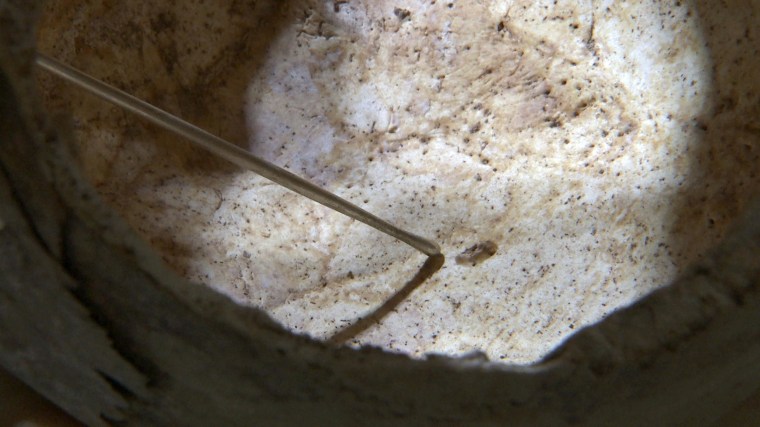It’s one thing to know that Richard III really was bludgeoned to death after losing his mount — just as Shakespeare described. It’s another to see the evidence come to light in real time more than 500 years later.
But there it is, a mark on the inside of his skull. The mark lines up with a big hole in the skull and damage to the spine, and suggests the last king from the House of York was killed when something hard and pointy was thrust up through the base of his skull and into his brain.
The University of Leicester, which has a team examining the bones dug up from under a parking lot in 2012, released a video Thursday showing the moment of discovery.
"It was one of those eureka moments,” says Guy Rutty of East Midlands Forensic Pathology Unit, who is shown pointing out the damage in the video.
"It was one of those eureka moments."
"Following the identification of a major sharp force trauma to the base of the skull, which was probably inflicted by a sword or the top spike of a bill or halberd, we were interested to determine the angle of the blow,” said osteologist (bone specialist) Jo Appleby, who’s been helping lead the investigation.

"During filming, Professor Rutty noted a small traumatic lesion on the interior surface of the cranium, directly opposite the sharp force trauma. Careful examination showed that the two injuries lined up with one another, and also with an injury to Richard's first cervical vertebra,” Appleby added in a statement.
"The combination of all three injuries provided evidence for the direction of the injury and also the depth to which the weapon had penetrated the skull."
The researchers described their discovery in a scientific paper a few months ago but released the video in a second report in the Lancet medical journal.
"Using modern forensic examination, we have discovered that Richard's skeleton sustained 11 wounds at or near the time of his death - nine of them to the skull, which were clearly inflicted in battle. The injuries to the head suggest he had either removed or lost his helmet. The other two injuries that we found were to a rib and his pelvis,” Sarah Hainsworth, a professor of material engineering at the university.
"The combination of all three injuries provided evidence for the direction of the injury."
A sword, a halberd or other staff-like weapon probably was used to kill Richard III in 1485 at the Battle of Bosworth, the researchers say.
Richard's death helped end England's decades-long War of the Roses. Tales tell of an inglorious end, his corpse tossed on top of a horse, kicked and desecrated and eventually buried with little ceremony at Leicester's Greyfriars Church. But the church was destroyed and for centuries, historians didn't know exactly where his bones were laid.
An archeological excavation found a promising set of bones beneath a Leicester parking lot in 2012, and DNA testing confirmed that the bones were Richard's. Since then, researchers have been trying to glean as much as they could from the remains before next year's ceremonial reinterment in Leicester Cathedral.
The researchers have already reconstructed his face, determined he had blond hair and blue eyes and confirmed he suffered several conditions in life — including a case of scoliosis that affected his posture, but didn't make him out to be the gruesome hunchback Shakespeare described.